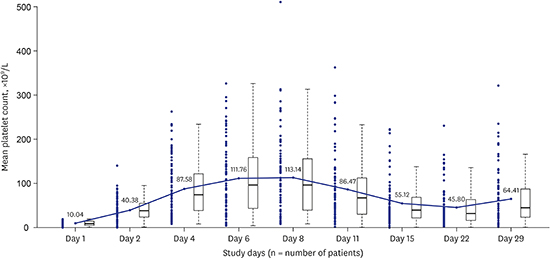1. Neunert C, Lim W, Crowther M, Cohen A, Solberg L Jr, Crowther MA, et al. The American Society of Hematology 2011 evidence-based practice guideline for immune thrombocytopenia. Blood. 2011; 117(16):4190–4207.

2. Jang JH, Kim JY, Mun YC, Bang SM, Lim YJ, Shin DY, et al. Management of immune thrombocytopenia: Korean experts recommendation in 2017. Blood Res. 2017; 52(4):254–263.

3. Schwartz RS. Immune thrombocytopenic purpura--from agony to agonist. N Engl J Med. 2007; 357(22):2299–2301.
4. Bierling P, Godeau B. Intravenous immunoglobulin for autoimmune thrombocytopenic purpura. Hum Immunol. 2005; 66(4):387–394.

5. Godeau B, Lesage S, Divine M, Wirquin V, Farcet JP, Bierling P. Treatment of adult chronic autoimmune thrombocytopenic purpura with repeated high-dose intravenous immunoglobulin. Blood. 1993; 82(5):1415–1421.

6. Robak T, Salama A, Kovaleva L, Vyhovska Y, Davies SV, Mazzucconi MG, et al. Efficacy and safety of Privigen, a novel liquid intravenous immunoglobulin formulation, in adolescent and adult patients with chronic immune thrombocytopenic purpura. Hematology. 2009; 14(4):227–236.

7. Robak T, Mainau C, Pyringer B, Chojnowski K, Warzocha K, Dmoszynska A, et al. Efficacy and safety of a new intravenous immunoglobulin 10% formulation (octagam® 10%) in patients with immune thrombocytopenia. Hematology. 2010; 15(5):351–359.
8. Radosevich M, Burnouf T. Intravenous immunoglobulin G: trends in production methods, quality control and quality assurance. Vox Sang. 2010; 98(1):12–28.

9. Bjøro K, Frøland SS, Yun Z, Samdal HH, Haaland T. Hepatitis C infection in patients with primary hypogammaglobulinemia after treatment with contaminated immune globulin. N Engl J Med. 1994; 331(24):1607–1611.

10. Rachid R, Bonilla FA. The role of anti-IgA antibodies in causing adverse reactions to gamma globulin infusion in immunodeficient patients: a comprehensive review of the literature. J Allergy Clin Immunol. 2012; 129(3):628–634.
11. Etscheid M, Breitner-Ruddock S, Gross S, Hunfeld A, Seitz R, Dodt J. Identification of kallikrein and FXIa as impurities in therapeutic immunoglobulins: implications for the safety and control of intravenous blood products. Vox Sang. 2012; 102(1):40–46.

12. Rodeghiero F, Stasi R, Gernsheimer T, Michel M, Provan D, Arnold DM, et al. Standardization of terminology, definitions and outcome criteria in immune thrombocytopenic purpura of adults and children: report from an international working group. Blood. 2009; 113(11):2386–2393.

13. Page LK, Psaila B, Provan D, Michael Hamilton J, Jenkins JM, Elish AS, et al. The immune thrombocytopenic purpura (ITP) bleeding score: assessment of bleeding in patients with ITP. Br J Haematol. 2007; 138(2):245–248.

14. Bussel JB, Eldor A, Kelton JG, Varon D, Brenner B, Gillis S, et al. IGIV-C, a novel intravenous immunoglobulin: evaluation of safety, efficacy, mechanisms of action, and impact on quality of life. Thromb Haemost. 2004; 91(4):771–778.

15. van der Meer JW, van Beem RT, Robak T, Deptala A, Strengers PF. Efficacy and safety of a nanofiltered liquid intravenous immunoglobulin product in patients with primary immunodeficiency and idiopathic thrombocytopenic purpura. Vox Sang. 2011; 101(2):138–146.

16. Dash CH, Gillanders KR, Stratford Bobbitt ME, Gascoigne EW, Leach SJ. Safety and efficacy of Gammaplex® in idiopathic thrombocytopenic purpura (ClinicalTrials.gov--NCT00504075). PLoS One. 2014; 9(6):e96600.
17. Varga G, Volková Z, Leibl H, Gasztonyi Z, Mayer J, Chojnowski K, et al. Efficacy and safety of the new intravenous immunoglobulin IGIV 10% in adults with chronic idiopathic thrombocytopenic purpura. Transfus Med Hemother. 2006; 33(6):509–514.

18. Julia A, Kovaleva L, Loria S, Alberca I, Hernandez F, Sandoval V, et al. Clinical efficacy and safety of Flebogammadif, a new high-purity human intravenous immunoglobulin, in adult patients with chronic idiopathic thrombocytopenic purpura. Transfus Med. 2009; 19(5):260–268.

19. Wolf HH, Davies SV, Borte M, Caulier MT, Williams PE, Bernuth HV, et al. Efficacy, tolerability, safety and pharmacokinetics of a nanofiltered intravenous immunoglobulin: studies in patients with immune thrombocytopenic purpura and primary immunodeficiencies. Vox Sang. 2003; 84(1):45–53.

20. Cines DB, Bussel JB. How I treat idiopathic thrombocytopenic purpura (ITP). Blood. 2005; 106(7):2244–2251.

21. Stasi R, Stipa E, Masi M, Cecconi M, Scimo MT, Oliva F, et al. Long-term observation of 208 adults with chronic idiopathic thrombocytopenic purpura. Am J Med. 1995; 98(5):436–442.

22. Rodeghiero F, Michel M, Gernsheimer T, Ruggeri M, Blanchette V, Bussel JB, et al. Standardization of bleeding assessment in immune thrombocytopenia: report from the International Working Group. Blood. 2013; 121(14):2596–2606.

23. Kim HS, Lee DH, Lee BK, Cho YS. Prognostic performance evaluation of the International Society on Thrombosis and Hemostasis and the Korean Society on Thrombosis and Hemostasis scores in the early phase of trauma. J Korean Med Sci. 2018; 33(3):e21.

24. Gabrielsson J, Weiner D. Non-compartmental analysis. Methods Mol Biol. 2012; 929:377–389.

25. Feng L. Epidemiological study of selective IgA deficiency among 6 nationalities in China. Zhonghua Yi Xue Za Zhi (Taipei). 1992; 72(2):88–90.
26. Kanoh T, Mizumoto T, Yasuda N, Koya M, Ohno Y, Uchino H, et al. Selective IgA deficiency in Japanese blood donors: frequency and statistical analysis. Vox Sang. 1986; 50(2):81–86.

27. Rhim JW, Kim KH, Kim DS, Kim BS, Kim JS, Kim CH, et al. Prevalence of primary immunodeficiency in Korea. J Korean Med Sci. 2012; 27(7):788–793.












 PDF
PDF Citation
Citation Print
Print




 XML Download
XML Download